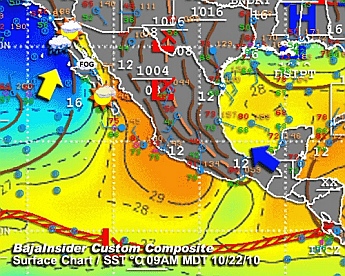
It's warmer down south.

Baja Ha-Ha Kickoff Party

Hugh and the bunnies.
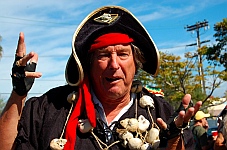
Latitude 38's "Grand Poo-Bah"
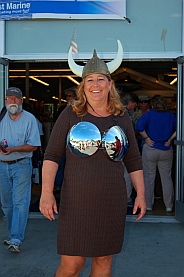
Greta, West Marine's store
manager

Two boats got a little too friendly.

Sailing to warmer climes.

The 2010 Baja Ha-Ha fleet takes off.
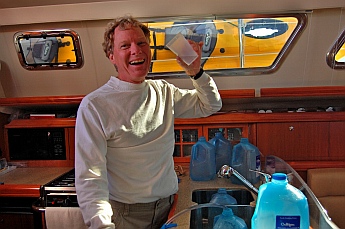
Fresh water from ocean water - at last.

Rocas Soledad

A kelp paddy forms a magic carpet for a dozen seagulls.

Sunset before our first overnight passage.
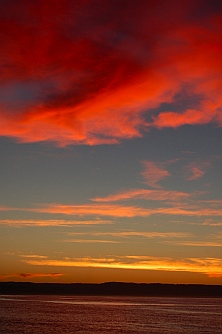
Sunrise the next morning.

An extinct volcano at San Quintín.

San Quintín.
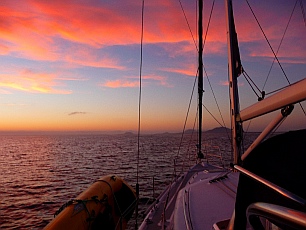
Another beautiful sunrise as we head south.
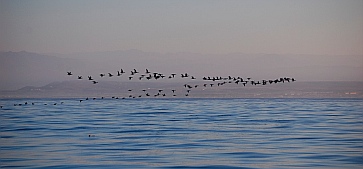
A wall of "kelp" suddenly took flight.

Islas San Benito loom eerily in the distance.

Dolphin Welcoming Committee at Cedros Island.

Cedros Island's southwest anchorage.

Southwest Cedros, a beautiful wide bay all to ourselves.
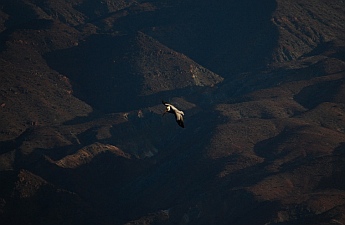
Pelican soaring at Cedros Island.
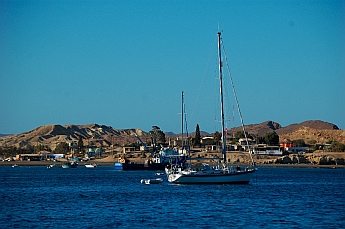
Turtle Bay anchorage.
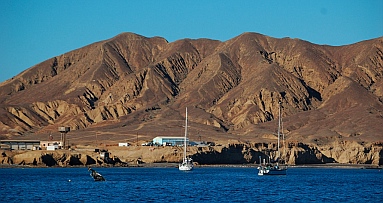
Turtle Bay.

Our boat approaches a waypoint outside Turtle Bay

Rock formations leaving Turtle Bay.

Bahía Asunción
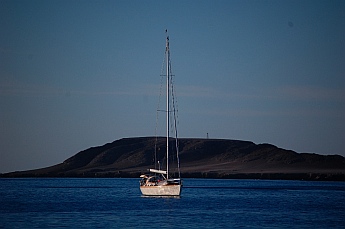
Isla Asunción.

Abreojos

An afternoon guest.

The sun sets behind our passage companions
"Wendaway."
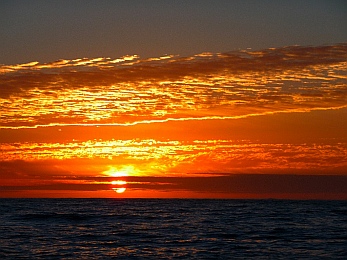
Sunrise approaching Bahia Santa Maria.

Alone on a bluff.

Black rock mountains protect the north end of
Bahia Santa Maria.

Groovy rests at Bahia Santa Maria
The Pacific Baja California Coast, Mexico
Late October to early November, 2010 - Sunny Southern California, and
its anchorages, had been buried under a fog bank for our entire two
month stay in San Diego. The sun peeked out here and there, but never
long enough to warm things up or dry them out, and the ten days of rain
in mid-October really took the cake. Almost everyone around the Police
Dock and the Cruisers Anchorage was heading to Mexico soon, and the
weather map showed exactly why.
The annual Baja Ha-Ha cruisers rally was the focus of attention on
Shelter Island as October progressed. A record 195 boats signed up for
the two week event, which sails from San Diego to Cabo San Lucas,
making two stops in Turtle Bay and Bahia Santa Maria. The kick-off
party at West Marine was a hoot. Held just before Halloween, this was a
crazy costume party where pirates and wenches showed up in full
regalia.
Most boats in the
rally have a crew of three to five people, and many of them came in
coordinated costumes. A group of jailbirds, a group of cereal killers
(Cap'n Crunch and all), a group of bird lovers with a real umbrella
cockatoo (who would be sailing too), and of course the requisite crew
from Gilligan's Island were all there. When Hugh Hefner and his playboy
bunnies made their entrance, all heads turned.
The dignitaries of
the event were also
in costume: the
"Grand Poo-Bah"
who publishes the
sponsoring magazine Latitude 38,
and Greta the indomitable general
manager of Shelter Island's West
Marine store. We have found
inspiration in many issues of
Latitude 38, and Greta has helped
us with countless purchases while
outfitting Groovy.
The beer flowed and the music played, but the next
morning was the official start for all those boats, so the
party didn't go too late. Sadly, San Diego produced yet another rainy morning for their
departure, and when two boats behind us got their anchors fouled, we were secretly glad we
weren't scrambling to leave with the group.
Instead, we hopped in our dinghy and raced out to see the boat parade as it sailed down San Diego harbor and out into the
open ocean. We listened as the group got coordinated on the VHF radio, setting themselves up to look their best for the
media boats filming for the local television stations. Despite the poor weather spirits were high, and every crew was looking
forward to getting down south.
Back on our boat, we had faced a delay in our departure because
the watermaker kit we purchased came with two leaky membranes.
The manufacturer gladly replaced them, but waiting for them to
arrive set our schedule back a bit. What a thrill it was when the new
membranes finally came and we were suddenly able to produce
drinking water from ocean water.
On November 2nd we left San Diego at last, bound first for Ensenada
where we cleared into Mexico and said "hello" and "goodbye" to our
many friends. Then we cast off on our long sail south.
A large swell had just passed ahead of us down the
coastal waters, causing high surf advisories all along the
west coast as it pounded its way down from the Pacific
Northwest. Besides the heaving and tossing we felt
onboard, we saw the surf crashing on the Rocas
Soledad rocks as we sailed past. What a surprise to
see a group of daredevil kayakers out there.
The large swell had swept huge paddies of kelp along
with it. These kelp carpets undulated along the top of
the water, gathering in groups as the currents pushed
them along, sometimes making it difficult to steer out of
their way. Many were large enough to be like small
floating islands, making nice resting spots for small
flocks of birds.
We wanted to stop at Puerto Santo Tomas, a few hours south of
Ensenada, but the little cove was blocked by an impenetrable
blanket of kelp. The next anchorage, Punta Colonet, was far
enough away that we would have arrived at night, so we decided
instead to sail all night and anchor in the anchorage after that, San
Quintín, at dawn. The sunset was stunning, and the night's
passage was lovely. There wasn't any wind, so we had to motor
the whole night, but sea was calm and the air was warm. It was a
new moon too, so the sky was pitch black, blending seamlessly into
the black sea.
Traveling alongside a blip on
the radar screen for an hour, and watching this neighboring boat's navigation light in the
dark, the captain suddenly hailed us on the radio and we chatted for a while. He was a
delivering a 75 foot motor yacht to La Paz and was going there non-stop. The balmy night
reminded him of his first night passage twenty years ago, and his dreamy recollections
lent a sense of calm to the intense darkness. As the sun rose the next morning we felt
triumphant.
San Quintín offers two
anchorages spaced three
miles apart. We saw
boats at the first
anchorage near the point
but continued on to the
further anchorage by the
beach. This is a serene
stretch of beach, except for the pounding surf, and we slept like babies after the long night
at sea. What a surprise it was the next morning to hear on the radio that the boats
anchored by the point had had a really rolly night and didn't sleep a wink.
We left just as day
was dawning, with
another overnight
passage planned
for that night.
As we were motoring along the rippling silver water, I suddenly saw
a wall of kelp blocking our way. It stretched as far as I could see on
both sides in front of us. I turned the boat quickly to avoid getting
caught up in it, only to see the entire mass of kelp suddenly take
wing and fly away.
On this passage we would head for Islas San Benito, a tiny group of three islands off the mid-coast of the Baja peninsula. We
had met the authors of the Sea of Cortez and Pacific Mexico cruising guidebooks while we were in San Diego, and they had
told us that these islands were the most remote, rugged and interesting of all the anchorages on the Baja coast. Anticipation
of landfall at these wild islands kept our spirits high during a challenging night passage. There was more than enough wind to
sail, but the seas were sizable, and we lurched along uncomfortably. The waves repeatedly picked up the whole boat and
heaved it to a new spot. We felt like we were sitting inside a washing machine in the dark. "There isn't anything about this that
I like," Mark said miserably. "And I'm so wide-eyed, I don't think I could open my eyes any wider!"
When morning arrived, our expectations were
quite high for these fabled islands, so what a
disappointment it was to have the weather
suddenly grow grim and cold. There would be
little incentive to get off the boat in layers of
jackets and hats to go hiking, and the anchorage
was a bed of kelp paddies to boot.
Totally let down, we turned the boat towards the
next anchorage, a nearby bay on the southwest end of Cedros Island. The guidebooks had little to say about this anchorage,
so we arrived with no expectations whatsoever. Suddenly, a group of dolphins came leaping towards the boat. While I ran for
the camera, Mark watched one dolphin leap straight up in the air five or six times, shooting up like a rocket out of the water.
His show was over by the time I got my lens cap off, but the rest of the dolphin welcoming committee provided great
entertainment for us as we motored into the bay.
The bay was immense, several miles across, and would
provide great accommodation for hundreds of boats. It is off
the beaten track, however, and we were the only boat there
for the night. Other than one fishing panga (pronounced
"ponga"), we didn't see a soul while we were there. The
pelicans were numerous, however, and we watched them
flying and fishing all around us. Again, we were spared from
any swell and we slept deeply.
When we left Cedros the next morning, fully rested and recovered
after that difficult previous night's passage sloshing about at sea, the
radio crackled with the conversations between other boats. Boats hail
each other by name on the radio, and we recognized the names of
many boats we had seen at the Police Dock and the Cruisers
Anchorage back in San Diego. Boats talk directly to one another, but
the airwaves are open to all, and most boaters eavesdrop on the
conversations of others. We were surprised to hear what a difficult
time everyone had had over the past two days. We weren't the only
ones who had been pitched and tossed while crossing the
Vizcaíno bay, but we were the only ones who had found a
peaceful anchorage for a good night's sleep. All the other boats
had spent the night on the north and east side of Cedros island
(we had been at the southwest end), and not only had they seen
wind gusts to 50 knots (we saw only 25 knots), but one boat
dragged its anchor a mile out to sea, where the sole person
aboard woke up with a shock to find himself nowhere near land.
Everyone was making their way towards Turtle Bay, and we joined
the procession into the anchorage late that afternoon. Turtle Bay
is the first stop for the Baja Ha-Ha rally, so we had heard a lot
about this anchorage. We hopped in our kayak and paddled
around to visit friends' boats. However, the cold air and biting
wind sent us back to the boat in a hurry. We didn't feel inclined to
go ashore through the choppy, nippy waves, so we stayed aboard
for a day and two nights, tidying up the boat, cat-napping, and
preparing for the upcoming segments of our trip.
I still find myself amazed at the electronic navigation equipment used
by boats today. Growing up in the era of paper charts and parallel
rulers, the power of an electronic chartplotter is stunning. Gone are
the days where you held the boat's wheel in one hand and a folded
chart in the other, squinting at the horizon and twisting the chart
around, trying to decide whether the bump of land in front of you is
the island on this part of the chart or the peninsula on that part of the
chart. Now you move a cursor to where you want to go and press
the "Go to cursor" button. Not only does the boat magically take you
there, correcting for any wayward currents as it goes, but the chart is
displayed with the boat at the center, and continually turns as the
boat turns, so you never have any question about where you are or
what you are looking at. Where the chart may be wrong (as is often
the case in Mexico because the original survey data is half a century
old), a radar overlay identifies the exact contours of the land. Truly,
every conceivable element of guesswork has been eliminated.
Our sail from Turtle Bay to Asunción was a delight. Bright sunshine
and lively wind combined to make a great sailing day. We have
rigged Groovy with two headsails, and we had a chance to fly them
together. We haven't perfected the rig yet, but it made for a
powerful downwind setup. An unexpected hail from another boat
yielded warm compliments on the rig. "It looks like the petals of a
flower."
The views along the coastline were dramatic too. Huge striated
rock mountains burst up along the shoreline.
Many boats headed south were buddy-boating, moving down the
coast in pairs. We followed the radio conversations of many of these
pairs of boats, getting a sense of their planned itineraries and the
challenges and joys they had experienced so far. During our sail to
Asunción we were overtaken by a pair of boats that had been
together since San Diego, Wendaway and Maja. We were friends
with the folks on Maja, but our schedules hadn't quite meshed at the
beginning of our trip so we hadn't sailed together yet. Now, on our
way to Asunción, we reconnected. And what lucky timing, as they
caught a 14 lb yellow fin tuna en route and shared the spoils when
we got to the anchorage. Yum!
We planned to do a short (20 mile) daysail from Asunción to San
Hipólito, but once we got out on the water the wind picked up and we
were flying along at 8.5 knots having a blast. As we neared San
Hipólito the conditions were too perfect to take the sails down and call
it a day. So we carried on towards Abreojos where Maja and
Wendaway were heading. No sooner had we decided to sail the extra
30 miles with them to Abreojos than the wind began to howl. "Should
we reef?" (shorten the sails to go a little slower), we asked each other.
Just at that moment the boat hit 9.2 knots and threatened to broach
(roll over on its side a little further than is comfortable). That
answered that, and we scrambled to take in the sails a bit. Of course,
no sooner did we get the sails set up for high winds than the wind died
all together, shifted direction, and then blew a nice gentle breeze on
us for the rest of the afternoon.
Abreojos means "Open eyes" in Spanish, and this is a
really good idea to do as you round the point on the
way in. There are rocks and reefs and crab pot
hazards everywhere. We tip-toed into the anchorage
trying not to get snagged. Mark kept his eyes glued to
the water through the binoculars, picking out a course
for us between the crab pots, while I followed the
chartplotter's contours along the 30 foot depth line
around the rock strewn reef. It made for a white
knuckle entrance as the sun was nearly setting. We
got in without a hitch, however. We planned to stay two nights there and rest up, but this was the first anchorage we'd stayed
at where the boat rolled continually, so our sleep was fitful and we didn't need a second night of that.
So we decided to sail with the other two boats on to Bahía Santa Maria the
next day, a 130 mile overnight run. Again, the sun shone brightly and the
wind was a sheer delight, coming perfectly over the beam on our best point of
sail. Grinning at each other and feeling very smug for having made it this far
on our ocean going adventure without sinking or dying, our jaws dropped as
we watched a little finch suddenly fly into the cockpit. We were 20 miles from
shore. After checking out a few spots in the cockpit he flew down into the
cabin, landing on the sofa, the TV, the bookcase, and the ledge by the
windows. I tried to coax him to stay, putting out a little bit of bread and water,
as I figured he must be tired and hungry. But after a few minutes of
assessing our boat and us, he decided he'd seen enough and he flew off.
That evening the
sun set in a spray of
fiery orange, as our companions on Wendaway sailed next to us. We
sailed side by side all night long, just a mile or two apart, again
comforted by the presence of another boat's light and blip on the
radar as we left the shore 50 dark cold miles to port.
We were awed by the half moon that rose in the early evening sky,
shining a bright path towards us along the water. It set as a bright
orange candy slice around midnight, its watery path changing from
silvery white to warm orange. The half moon laid on its back, and as
it sank into the horizon it looked like a little orange boat out at sea.
The next morning brought more celestial fireworks. The
looming black rock hills that form one of the protecting
peninsulas of Bahía Santa Maria rose alongside us as we
motored towards the entrance to the bay.
A lone building on a bluff welcomed us in, and a tranquil
anchorage awaited us on the other side. A peaceful day
or two here would set us up the remaining miles of our
passage down the Baja Pacific Coast.
Find these Pacific Baja anchorages on Mexico Maps.
